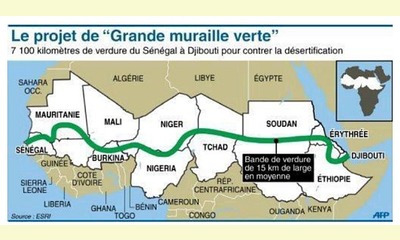|
|
A Great Green Wall Across the African Continent
un articulo por Kiki Chauvin
When you look carefully at Saharan Africa (the Sahel), the view is harsh and painful: about two million hectares of forests disappear every year. The desert is advancing rapidly, turning populations from a precarious existence into nomads without hope.

click on photo to enlarge
In 1977, Wangari Maathai founded in Kenya the Green Belt Movement. The project of the struggle against desertification in the Sahel region. Later on, at a meeting in Ouagadougou, 11 of the 28 countries of CEN-SAD (the Community of Sahel-Saharan States), committed themselves to an even greater and more remarkable plan: to plant a belt of vegetation 15 kilometers wide from Dakar, Senegal, to Djibouti, by way of Mauritania, Mali, Burkina Faso, Niger, Nigeria, Chad, Sudan, Eritrea and Ethiopia, millions of hectares over a distance of 7,000 kilometers!
I found a lot of information about this project on the website www.grandemurailleverte.org.
Since 2008 Senegal has planted an average of 5000 hectares per year, with a total now estimated at 80,000. Niger and Chad had already begun to develop green spaces before participating in the project.
The criteria for success vary according to the country and their contact, but there is a common base of conditions and engagements for all of them:
- Average rainfall should be less than 400 mm, in order to give preference to plants able to resist droughts
- The green species should involve indigenous and diversified vegetation, already familiar to local populations, in conformity with the habits, traditions and specificities of the regions concerned.
- Reforestation and maintenance of the spaces should involve local populations using their traditional knowledge.
- Development of the local economy should parallel the development of the Green Belt so as to allow subsistence agriculture, livestock and medicinal plants, as well as added income for the fight against poverty.
- Finally, a new way to manage water (catch basins, forages, and further development of existing systems) which should greatly improve the quality of life.
In 2010, the Panafrican Agency Responsible for the Great Green Wall was created to coordinate the creation of the wall of vegetation. The budget, directed by the Global Environment Facility, GEF, was set at 119 million dollars.
As expressed by one of the initiators, “This project is a great challenge, but it consists of proving an African response to an African problem.
Reading the different accounts of this initiative that I researched for this article made me reflect on certain points:
Although the project was conceived on a grand scale, continental in scope, the actions must take place at a local level. This illustrates the principle: “think globally, act locally.” And I see the advantage here that the populations of different villages, communities and cities will develop mutual understanding, respect and confidence.
Political instability in some of the regions may impede the development of the project. The violence of wars, the pressure of famines and all their consequences are unfortunately ever present. However, the great breadth of this enterprise illustrates the motivation of the populations concerned: to regain the right to live in dignity through solidarity.
The Great Green Wall should keep alive the color of hope!
Click here for the original French version of this article.
|








|
DISCUSSION
Pregunta(s) relacionada(s) al artículo :
When you cultivate plants, do you cultivate peace?,
* * * * *
Comentario más reciente:
:
CPNN has just received the following message (see a rough English translation below):
CPNN vient de recevoir le message suivant:
Merci pour ces informations
D'ailleurs par rapport au climat , aujourd hui 11 Décembre est notre journée locale de l'arbre (pour le climat et la culture).
Nous avons planté des arbres fruitiers pour faire revivre nos traditions (notre culture) qui voulaient que la retraite des paysans s'assurait par les arbres fruitiers. Aussi la plante de MURINGA pour symboliser les plantes médicinales et fin une espéce sauvage d'arbre dont les feuilles sont mangées par les chenilles (comestibles à l homme).
C'est 2 ans que nous organisons cette journée et nous faisons des émissions à la radio et TV pour la vulgarisation de cette culture de la paix (manger, planter pour le générations futures et le climat du monde entier)
Solidarité
victor nzuzi
rd congo
********************
CPNN has just received the following message which is translated here (see above for the original French version).
Thank you for the information.
With regards to climate change, today December 11 is our local "day of the tree" (for our climate and our culture). We have planted fruit trees to revive our traditions (our culture), to assure with fruit trees the retirement of our local farmers . Also the planting of MURINGA to symbolize medicinal plants, a wild species of tree whose leaves are food for caterpillars that we can eat.
It's been two years now that we organize this day and we broadcast radio and TV programs to popularize this culture of peace (eat and plant for future generations and for the climate of the whole world).
In solidarity,
Victor Nzuzi
Democratic Republic of the Congo

|
|









